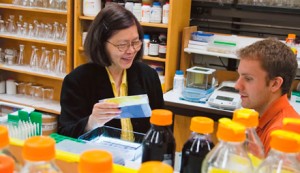 Binghamton University has been awarded a four-year, $1.4 million grant by the Howard Hughes Medical Institute (HHMI) to fund undergraduate interdisciplinary research opportunities around the theme of solving problems in the life sciences.
Binghamton University has been awarded a four-year, $1.4 million grant by the Howard Hughes Medical Institute (HHMI) to fund undergraduate interdisciplinary research opportunities around the theme of solving problems in the life sciences.
Fifty research-focused universities from a potential field of 197 institutions across the country were awarded grants; Binghamton University joins a list of recipients that includes Harvard, Yale, Cornell and the College of William and Mary. Binghamton and Stony Brook are the only two SUNY schools to be recognized.
With science becoming more collaborative and interdisciplinary, life science and medical research is increasingly dependent on scientists and engineers who can work across disciplines. With the help of the HHMI grant, Binghamton undergraduates will have more opportunities to cross those disciplinary boundaries.
“Biology is incorporating more mathematics, engineering, physics and computer science,” said Anna Tan-Wilson, a Binghamton University distinguished teaching professor of biological sciences and HHMI program director. “In the real world, those boundaries are blurring.”
The grant will fund a program that teams undergraduate majors in the life sciences with students in the physical sciences, mathematics, computer science and engineering to work on collaborative, interdisciplinary research projects in the life sciences.
Tan-Wilson expects to launch the program in fall 2010 with a series of workshops where faculty can meet to propose collaborative projects for the undergraduates. At the same time, Tan-Wilson will start taking student applications. She plans to sign up about 30 undergraduates and hopes to recruit students from underrepresented minorities in science, engineering and mathematics.
Teams will begin their research projects in summer 2011 and will continue working together for the following academic year. Along the way, they will be trained in how to work effectively across disciplines. Graduate students will also be trained as mentors.
“We also want to work with them because these PhD students will be faculty members someday,” said Nancy Stamp, dean of the Graduate School and grant co-program director.
Binghamton is also interested in understanding how students in the program will develop. Krishnaswami (Hari) Srihari, dean and distinguished professor of systems science and industrial engineering in the Thomas J. Watson School of Engineering and Applied Science, will observe the students as they work and use data to model the social interactions of the interdisciplinary teams. They will use what they learn to determine what factors help interdisciplinary students grow into independent scholars and better match students to faculty mentors.
“What are the conditions that make for success?” asked Tan-Wilson. “Or, how can we ensure that students don’t get frustrated with the challenges of interdisciplinary work? We want to find out what makes for the kind of fulfilling experience that then translates into careers in biologically-based research.”
About the Howard Hughes Medical Institute (HHMI)
HHMI, a nonprofit medical research organization that ranks as one of the nation’s largest philanthropies, plays a powerful role in advancing biomedical research and science education in the United States. The institute spent $730 million for research and distributed $101 million in grant support for science education in fiscal year 2009. Its scientists, located across the country and around the world, have made important discoveries that advance human health and our fundamental understanding of biology. The institute also aims to transform science education into a creative, interdisciplinary endeavor that reflects the excitement of real research.







